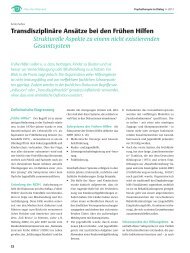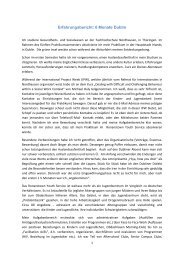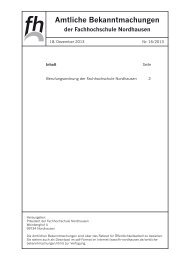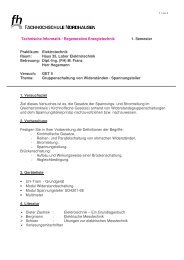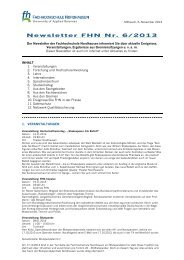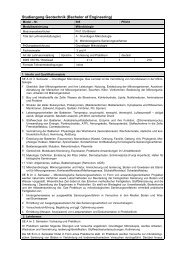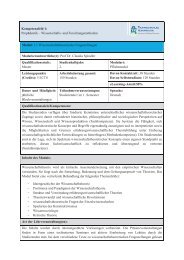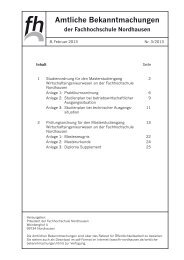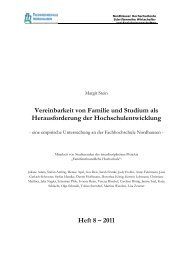Simple Methods and Procedures Used in Forecasting
Simple Methods and Procedures Used in Forecasting
Simple Methods and Procedures Used in Forecasting
You also want an ePaper? Increase the reach of your titles
YUMPU automatically turns print PDFs into web optimized ePapers that Google loves.
<strong>Simple</strong> <strong>Methods</strong> <strong>and</strong><br />
<strong>Procedures</strong> <strong>Used</strong> <strong>in</strong><br />
Forecast<strong>in</strong>g<br />
The project prepared by : Sven G<strong>in</strong>gelmaier<br />
Michael Richter<br />
Under direction of the Maria Jadamus-Hacura
What Is Forecast<strong>in</strong>g?<br />
Prediction of future events <strong>and</strong> conditions are<br />
called forecasts, <strong>and</strong> the act of mak<strong>in</strong>g such<br />
prediction is called forecast<strong>in</strong>g.<br />
(WordNet Dictionary )<br />
Sales will be $200<br />
million!
Forecast<strong>in</strong>g <strong>Methods</strong> <strong>Used</strong> <strong>in</strong><br />
the Project :<br />
L<strong>in</strong>ear trend model<br />
Exponential smooth<strong>in</strong>g models :<br />
- Brown´s l<strong>in</strong>ear exponential smooth<strong>in</strong>g<br />
- Browns quadratic smooth<strong>in</strong>g model<br />
- Holt´s method double exponential smooth<strong>in</strong>g<br />
- Nonl<strong>in</strong>ear smooth<strong>in</strong>g model
Time Series Analysis<br />
Time series, denoted by { Y t : t ∈ N} , is a<br />
sequence of observations on particular<br />
variables.<br />
Decomposition of time series data (classical<br />
decomposition):<br />
Trend<br />
Seasonal Trend<br />
Cyclical Movements<br />
Irregular Components
The data that has been analyzed <strong>in</strong> the<br />
Project are :<br />
- number of born Baby´s <strong>in</strong> Germany<br />
- analyzed period starts from 1990 to<br />
2007<br />
- the Data was taken from the Website<br />
of the German Census Office
L<strong>in</strong>ear Trend Analysis<br />
950000<br />
900000<br />
850000<br />
800000<br />
750000<br />
700000<br />
650000<br />
600000<br />
L<strong>in</strong>ear Trend<br />
y = -10405t + 860988<br />
R 2 = 0,8497<br />
1 2 3 4 5 6 7 8 9 10 11 12 13 14 15 16 17 18 19<br />
empircal data L<strong>in</strong>ear (empircal data)
L<strong>in</strong>ear Trend Analysis<br />
We applied Ord<strong>in</strong>ary Least Squares<br />
Method ( OLS ) to estimate coefficients<br />
<strong>and</strong> the measures of fit of the l<strong>in</strong>ear<br />
trend model .<br />
We utilized Excel regression option for<br />
calculation . ( Tools / Data Analysis /<br />
Regression )
SUMMARY OUTPUT<br />
Regression Statistics<br />
Multiple R 0,9217700<br />
R Square 0,8496599<br />
Adjusted R Square 0,8402637<br />
St<strong>and</strong>ard Error 24085,46 V= 3,16%<br />
Observations 18<br />
ANOVA<br />
df SS MS F Significance F<br />
Regression 1 52456625447 52456625447 90,42538644 5,50673E-08<br />
Residual 16 9281751953 580109497,1<br />
Total 17 61738377400<br />
Coefficients St<strong>and</strong>ard Error t Stat P-value Lower 95%<br />
Intercept 860988,4379 11844,32006 72,69209493 1,35626E-21 835879,6012<br />
t -10405,26832 1094,228689 -9,509226385 5,50673E-08 -12724,9295
L<strong>in</strong>ear Trend Analysis<br />
L<strong>in</strong>ear trend equation:<br />
Y )<br />
)<br />
Y = 860988,43 −10405,27*<br />
t<br />
- Estimated or predicted value of born baby´s<br />
Interpretation of slope coefficient :<br />
Here b 1 = 10405,27 tells us that the average<br />
value of born baby´s decreases by 10405<br />
on average <strong>in</strong> each year .
Measures of fit<br />
-The Coefficient of Determ<strong>in</strong>ation R2<br />
-St<strong>and</strong>ard Error of Estimate Su<br />
- Coefficient of r<strong>and</strong>om variation V
Coefficient of<br />
Determ<strong>in</strong>ation, R 2<br />
The coefficient of determ<strong>in</strong>ation is the<br />
portion of the total variation <strong>in</strong> the<br />
dependent variable that is expla<strong>in</strong>ed by<br />
variation <strong>in</strong> the <strong>in</strong>dependent variable<br />
In our example R 2 =0,8496.<br />
It means that 84 % of the total variation of<br />
the number of born baby´s is expla<strong>in</strong>ed by<br />
the trend model .
St<strong>and</strong>ard Error of<br />
Estimate<br />
S u = 24085,46<br />
It is the st<strong>and</strong>ard deviation around<br />
the trend l<strong>in</strong>e of the predicted<br />
values of Y.
Coefficient of r<strong>and</strong>om<br />
variation<br />
V = 3,16%<br />
The value of st<strong>and</strong>ard error is around<br />
3% of the mean of the number of born<br />
baby´s .
Predicted Value<br />
We estimate the value of born baby´s <strong>in</strong> the year<br />
2008 by extrapolation trend function for t = 19 :<br />
)<br />
Y = 860988,43 − 10405, 27*19 = 663288,34<br />
The real number of born baby´s <strong>in</strong> Germany <strong>in</strong> the year 2008 is<br />
674728 .<br />
The ex post error of estimation is equal to :<br />
674728 – 663288,34 = 11439,7<br />
This error is less than estimated from the regression model .<br />
( S u = 24085,5 )
Exponential Exponential Exponential Smooth<strong>in</strong>g<br />
Smooth<strong>in</strong>g<br />
<strong>Methods</strong><br />
<strong>Methods</strong><br />
Exponential smooth<strong>in</strong>g has become<br />
very popular as a forecast<strong>in</strong>g method<br />
for a wide variety of time series data.<br />
The predicted value <strong>in</strong> this method is a<br />
weighted average of past observations .<br />
Weights decay geometrically as we go<br />
backwards <strong>in</strong> time .
Brown's L<strong>in</strong>ear (double)<br />
Exponential Smooth<strong>in</strong>g<br />
950.000<br />
900.000<br />
850.000<br />
800.000<br />
750.000<br />
700.000<br />
650.000<br />
600.000<br />
1 2 3 4 5 6 7 8 9 10 11 12 13 14 15 16 17 18 19 20 21 22 23<br />
actual smoothed data<br />
forecast
Brown's quadratic<br />
(triple) smooth<strong>in</strong>g model<br />
950000<br />
900000<br />
850000<br />
800000<br />
750000<br />
700000<br />
650000<br />
600000<br />
1 2 3 4 5 6 7 8 9 10 11 12 13 14 15 16 17 18 19 20 21 22 23<br />
data forecasts
Holt's method double<br />
exponential smooth<strong>in</strong>g<br />
950000<br />
900000<br />
850000<br />
800000<br />
750000<br />
700000<br />
650000<br />
600000<br />
forecast<br />
1 3 5 7 9 11 13 15 17 19 21 23<br />
actual smoothed data
Nonl<strong>in</strong>ear smooth<strong>in</strong>g<br />
950.000<br />
900.000<br />
850.000<br />
800.000<br />
750.000<br />
700.000<br />
650.000<br />
600.000<br />
model<br />
1 3 5 7 9 11 13 15 17 19 21 23<br />
actual smoothed data<br />
forecast
Summary of Results<br />
Brown's L<strong>in</strong>ear (double) Exponential<br />
Smooth<strong>in</strong>g<br />
Brown's quadratic ( triple) smooth<strong>in</strong>g<br />
model<br />
Holt's method double exponential<br />
smooth<strong>in</strong>g<br />
Nonl<strong>in</strong>ear smooth<strong>in</strong>g<br />
model<br />
Real value of born baby´s <strong>in</strong> the<br />
year 2008<br />
MAE<br />
19932<br />
29244<br />
17831<br />
16726<br />
Forecasted<br />
value<br />
for<br />
2008<br />
676589<br />
698999<br />
672391<br />
677927<br />
674728<br />
ex post<br />
error<br />
-1861<br />
-24271<br />
2337<br />
-3199<br />
absolute<br />
value of<br />
ex post<br />
error<br />
1861<br />
24271<br />
2337<br />
3199
Summary of Results<br />
705000<br />
700000<br />
695000<br />
690000<br />
685000<br />
680000<br />
675000<br />
670000<br />
665000<br />
660000<br />
655000<br />
( graphically )<br />
Brown's L<strong>in</strong>ear<br />
(double) Exponential<br />
Smooth<strong>in</strong>g<br />
Brown's quadratic<br />
(ie, triple) smooth<strong>in</strong>g<br />
model<br />
Holt's method<br />
double exponential<br />
smooth<strong>in</strong>g<br />
forecasted value<br />
real value<br />
Nonl<strong>in</strong>ear smooth<strong>in</strong>g<br />
model
710000<br />
700000<br />
690000<br />
680000<br />
670000<br />
660000<br />
650000<br />
640000<br />
General Comparison<br />
Brown's L<strong>in</strong>ear<br />
(double)<br />
Exponential<br />
Smooth<strong>in</strong>g<br />
Brown's<br />
quadratic (ie,<br />
triple) smooth<strong>in</strong>g<br />
model<br />
(graphically)<br />
Holt's method<br />
double<br />
exponential<br />
smooth<strong>in</strong>g<br />
Forecasted value for 2008<br />
real value<br />
Nonl<strong>in</strong>ear<br />
smooth<strong>in</strong>g model<br />
Trend model<br />
35000<br />
30000<br />
25000<br />
20000<br />
15000<br />
10000<br />
5000<br />
0<br />
Brown's<br />
L<strong>in</strong>ear<br />
(double)<br />
Exponential<br />
Smooth<strong>in</strong>g<br />
Brown's<br />
quadratic (ie,<br />
triple)<br />
smooth<strong>in</strong>g<br />
model<br />
Holt's method<br />
double<br />
exponential<br />
smooth<strong>in</strong>g<br />
MAE<br />
absolute value of ex post<br />
error<br />
Nonl<strong>in</strong>ear<br />
smooth<strong>in</strong>g<br />
model<br />
Trend model
THANK YOU FOR<br />
LISTENING



